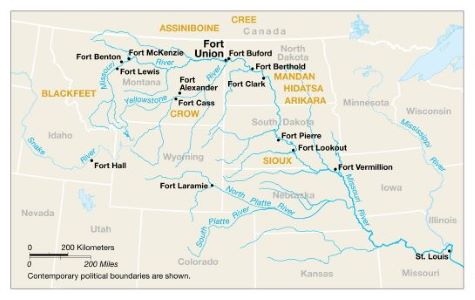Last updated: October 29, 2020
Lesson Plan
Fort Union Fur Trade Overview

- Grade Level:
- Upper Elementary: Third Grade through Fifth Grade
- Subject:
- Social Studies
- Lesson Duration:
- 60 Minutes
- Common Core Standards:
- 4.RI.1, 4.RI.3, 4.RI.5, 5.RI.3, 5.RI.4, 5.RI.5, 5.RI.6
- State Standards:
- State: North Dakota
Subject: Social Studies
Grade Levels: K-4
4.2.5
4.2.7
4.6.1
4.6.2
State: North Dakota
Subject: Social Studies
Grade Levels: 5-8
8.1.2
8.2.4
8.6.1
8.6.2
Essential Question
What is the fur trade? Who was involved in the fur trade? Where did the fur trade take place? What was the organization of a fur trade company like? What was the relationship between fur traders (immigrants) and American Indians?
Objective
In this lesson, students will answer the following essential questions:
What is the fur trade? Who was involved in the fur trade? Where did the fur trade take place? What was the organization of a fur trade company like? What was the relationship between fur traders (immigrants) and American Indians?
Background
For 39 years, Fort Union was the longest-lasting and most profitable fur trading post on the Upper Missouri River. Here seven Northern Plains Indian Tribes, including the Assiniboine, traded buffalo robes and other furs for goods such as cloth, guns, blankets, and beads. A bastion of peaceful coexistence, this fort annually traded over 25,000 buffalo robes and $100,000 of merchandise. In this lesson, students will explore what the fur trade is, who it involved, and where it took place.
Preparation
-
Decide whether to have students work individually, in partners, or in groups.
-
Decide if you will split the class into breaking down both readings simultaneously, or all together one at a time.
-
Get The Trade House video ready to play
-
Identify students who may need support or an extra challenge.
-
Make one copy of the Fort Union Fur Trade Overview – Student Document for each student and/or group.
Materials
This is a document with the readings and worksheets for the students to be able to complete the lesson.
Download Fort Union Fur Trade Overview – Student Document
Lesson Hook/Preview
Option One: Play The Trade House video.
Option Two: Ask students if they ever had to communicate with someone who was different from them. Did they speak a different language? What ways did you try to communicate without speaking? Have you ever gone somewhere and needed to buy something but YOU were the stranger that didn’t know the language or didn’t understand? How did you feel, what did you do?
Procedure
-
Do Now Activity: Using classroom discussion and brainstorming find synonyms for important key vocabulary terms.
-
Have each student read the summary of the Trade Process and Players. Can be done as guided reading. Have students annotate as they read noting key players or steps in the trade process. (Option: students could be in two groups, group 1 doing steps 2 & 3, while the other half completes 5 & 6 – then switch.)
-
Have students work in small groups to answer questions in student packet. Assist struggling students by prompting them with a particular player or action of the trade.
-
Have all students watch The Trade House video.
-
Have students read Fort Union History. Can be done as guided reading. Have students brainstorm the meaning of underlined words using context clues, finding synonyms, referring to Do Now activity, etc.
-
Have students work in small groups to answer questions in student packet. Assist struggling students by prompting them to refer to specific paragraphs for information.
-
At the end of the lesson prompt students to answer questions about the fur trade. Share out answers. If you chose to split the class in half, have students mix and mingle to compare answers.
Vocabulary
-
Trade: an exchange of items, usually without payment of money.
-
Bourgeois: a shopkeeper or merchant.
-
Engage: to bind, as by pledge, promise, contract, or oath; make likable
-
Clerk: a person who sells goods in a store.
-
Trader: a person who trades; a merchant or business person.
-
Interpreter: a person who provides an oral translation between speakers who speak different languages.
-
Assiniboine: a member of a North American Indian people living in Alberta, Saskatchewan, and Montana; one of the Sioux peoples
-
Legal: permitted by law; lawful
-
Commercial: of, relating to, or characteristic of commerce.
-
Enterprise: a company organized for commercial purposes; business firm.
- Metropolis: the chief, and sometimes capital, city of a country, state, or region.
Supports for Struggling Learners
1. Have students brainstorm on vocabulary words.
2. Prompt students to take one paragraph of the text at a time and annotate the reading.
Enrichment Activities
1. Have high performing learners create a graphic organizer or poster of the organizational structure of a fur trade company.
2. Create a graphic organizer/picture to represent the trade process (timeline, cycle, etc.)
Additional Resources
Fort Union Multimedia Resources
